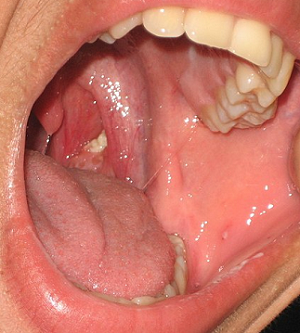Tonsil stones
Tonsilloliths
Peer reviewed by Dr Toni Hazell, MRCGPLast updated by Dr Philippa Vincent, MRCGPLast updated 17 Dec 2024
Meets Patient’s editorial guidelines
- DownloadDownload
- Share
- Language
- Discussion
In this series:Sore throatTonsillitisTonsillectomyGlandular fever
Tonsil stones are stones which can form at the back of the throat within the tonsils. They are not serious but can sometimes cause problems with a sore throat or bad breath.
In this article:
Continue reading below
What are tonsil stones?
Tonsil stones, otherwise known as tonsilloliths, are a white or yellow accumulation of debris at the back of the throat. They tend to occur in people who have large or craggy tonsils.
Tonsils are the soft lumps at the back of your throat, one at each side. They are lymph nodes which sometimes enlarge to help fight infection.
Not everyone has visible tonsils - people whose tonsils are not visible are unlikely to develop tonsilloliths. Some people have large tonsils with craggy ridges in them.
What do tonsil stones look like?
Tonsil stones

By Glacko2021 at English Wikipedia, via Wikimedia Commons
They look like small white, yellow or pale grey pebbles, in the nooks and crannies of the tonsils.
Continue reading below
What causes tonsil stones?
Tonsil stones are made up of minerals - mainly calcium salts. Debris from the surrounding cells, tissues and bacteria gets stuck in the crevices of the tonsils and then hardens (becomes calcified). They can be hard, like tiny rocks, or quite soft. They are usually quite small, but can sometimes get bigger.
They are not cancerous growths, and they are not attached to the tissues around them, but instead are stuck in the crevices of the tonsils.
Tonsil stones can actually help the immune system by blocking bacteria and viruses from entering the body.
Tonsilloliths can occur at any age but are more common in adults than in children. Some people just develop one, whereas others can have more than one at a time. In some people, when they get rid of one, another forms somewhere else on their tonsils.
Why do I keep getting tonsil stones?
Some people are more prone than others to developing tonsil stones.
Risk factors include:
Smoking.
Poor oral hygiene.
Recurrent tonsil infections.
Having tonsillar crypts.
Tonsillar crypts are the folds, gaps and crevices found in some people's tonsils. They are more common in larger or craggy-looking tonsils.
Continue reading below
What are the symptoms of tonsil stones?
Often there are no symptoms of tonsil stones at all, though when there are they may include :
A feeling of something being stuck at the back of the throat.
Discomfort swallowing.
A bad taste in the mouth.
An irritating cough.
Earache (sometimes a problem in the mouth can 'radiate' to the ear due to the way that the pain signal is carried along nerves).
Are any tests needed for tonsil stones?
Usually tonsil stones (tonsilloliths) can be seen at the back of the mouth and no special tests are needed. Sometimes they are seen coincidentally on X-rays or scans which have been done for other reasons.
How to get rid of tonsil stones
In many cases tonsil stones can be removed at home. Treatment is not necessarily needed, especially if there are no symptoms.
Salt water gargle. Try gargling with mouthwash or a salty water solution. This may dislodge the tonsil stones.
Gentle irrigation. This involves gently shooting water at the back of the mouth to try to dislodge tonsil stones. It is possible to buy a syringe specially for this purpose, which has a curved tip, or an irrigation kit. It is important to follow the instructions carefully, as it is possible to damage the tonsils if too much force is used. This may cause pain and bleeding.
Cotton swabbing. Gently massaging around the tonsils with a cotton swab can push the tonsil stone loose.
Surgical removal. An ear, nose and throat (ENT) surgeon can remove tonsil stones which are causing problems but this will only be done if the tonsil stones are:
Large in size.
Painful.
Causing repeated bacterial infections and sore throats.
A dentist may be able to help with the problem and can make the referral if needed.
How to prevent tonsil stones
Good oral hygiene helps with preventing tonsil stones. Teeth should be brushed twice a day, as advised by dentists, including the spaces in between them, to stop any debris accumulating.
Consider a tongue scraper to keep the tongue clear of any gunk or germs which might contribute to a stone forming.
Regular gargling with a mouthwash or salt water solution may also help.
Avoid smoking and excess alcohol which can cause the mouth to be dry and may make tonsilloliths or tonsil stones more likely to build up.
For some people, an operation to flatten the surfaces of the tonsils may help to stop persisting problems with tonsilloliths recurring. This is called cryptolysis and can be done either by laser treatment or another type of treatment called coblation cryptolysis. This may need a general anaesthetic but is not available on the NHS.
Occasionally, removal of the tonsils (tonsillectomy) is recommended to prevent ongoing problems with tonsil stones.
Patient picks for Throat and tonsils

Ear, nose and throat
Epiglottitis
Epiglottitis is the term used to describe inflammation and swelling of the epiglottis which lies just behind the root of the tongue. It is usually caused by infection with a bacteria. The usual symptoms are a severe sore throat, pain or difficulty swallowing and a high temperature (fever). Breathing difficulties can occur. Prompt treatment is needed to ensure that enough oxygen can reach the lungs and usually includes antibiotics. If epiglottitis is treated quickly, the outlook is generally very good. Untreated, it can be life-threatening. Since immunisation against Hib was introduced, the number of children who develop epiglottitis in the UK has reduced dramatically.
by Dr Philippa Vincent, MRCGP

Ear, nose and throat
Tonsillitis
Tonsillitis is an infection of the tonsils that causes them to become swollen and sore. It is usually caused by a virus, but can also be caused by bacterial infections. Most cases improve within a week with rest, fluids, and pain relief, however, bacterial tonsillitis may require antibiotics. This leaflet discusses the symptoms, causes, treatments, and when to see a doctor.
by Dr Philippa Vincent, MRCGP
Further reading and references
- Bamgbose BO, Ruprecht A, Hellstein J, et al; The prevalence of tonsilloliths and other soft tissue calcifications in patients attending oral and maxillofacial radiology clinic of the university of iowa. ISRN Dent. 2014 Jan 22;2014:839635. doi: 10.1155/2014/839635. eCollection 2014.
- Halitosis; NICE CKS, September 2024 (UK access only)
- Shikino K, Ikusaka M; Tonsillolith. Clin Case Rep. 2021 Jun 22;9(6):e04243. doi: 10.1002/ccr3.4243. eCollection 2021 Jun.
Continue reading below
Article history
The information on this page is written and peer reviewed by qualified clinicians.
Next review due: 16 Dec 2027
17 Dec 2024 | Latest version
13 Sept 2018 | Originally published
Authored by:
Dr Mary Harding, MRCGP

Ask, share, connect.
Browse discussions, ask questions, and share experiences across hundreds of health topics.

Feeling unwell?
Assess your symptoms online for free
Sign up to the Patient newsletter
Your weekly dose of clear, trustworthy health advice - written to help you feel informed, confident and in control.
By subscribing you accept our Privacy Policy. You can unsubscribe at any time. We never sell your data.